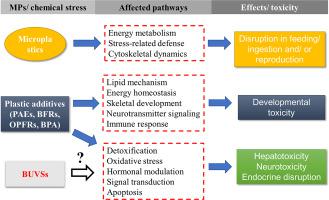Comparative Biochemistry and Physiology D: Genomics & Proteomics ( IF 2.2 ) Pub Date : 2020-08-04 , DOI: 10.1016/j.cbd.2020.100713 Wang Liu , Yaqian Zhao , Ziyue Shi , Zhitong Li , Xuefang Liang

|
Advances in proteomics have greatly improved chemical toxicity assessment and predictions of adverse outcomes in organisms. Ecotoxicoproteomics has been employed to elucidate biological pathways affected by chemicals and provide data that can be incorporated into adverse outcome pathways (AOP) to better define the ecological risk of emerging pollutants. Microplastics (MPs) and plastic additives have raised global concern due to their widespread use in aquatic environments, bioaccumulation in tissues, and toxic effects in aquatic organisms. Despite showing sublethal toxicity in many cases, mechanisms underlying these emerging pollutants are underexplored. In this review, adverse effects and recent ecotoxicoproteomic studies of MPs and typical additives (i.e. plasticizers, flame retardants, antioxidants, and UV stabilizers) in aquatic organisms are summarized. Proteomics data show that MPs adversely affect ingestion and reproduction via disrupting pathways related to energy metabolism, stress-related defense, and cytoskeletal dynamics. Biological processes including lipid metabolism, energy homeostasis, skeletal development, neurotransmitter signaling, and immune response are modulated by additives and induce developmental malformations in fish embryos/larvae. Furthermore, plastic additives also exert reproductive toxicity, hepatotoxicity, and neurotoxicity in invertebrates (e.g. mussel, abalone, and oyster) and fish by disrupting detoxification/oxidative stress, hormonal modulation, signal transduction, and apoptosis. Additional studies are needed to complement the omic knowledge of chemical additives that are not well documented (e.g. UV stabilizers) for improving understanding into toxic mechanisms and for characterizing ecological risk linked to plastic contaminants.
中文翻译:

水生生物中微塑料和塑料添加剂的生态毒理学评估:综述
蛋白质组学的进步极大地改善了化学毒性评估和生物体不良后果的预测。生态毒理学已被用于阐明受化学物质影响的生物途径,并提供可纳入不良结果途径(AOP)的数据,以更好地确定新兴污染物的生态风险。由于微塑料(MPs)和塑料添加剂在水生环境中的广泛使用,组织中的生物蓄积以及在水生生物中的毒性作用,引起了全球关注。尽管在许多情况下显示出亚致死毒性,但仍未充分研究这些新兴污染物的潜在机制。在这篇评论中,对MP和典型添加剂(即增塑剂,阻燃剂,抗氧化剂,以及水生生物中的紫外线稳定剂)。蛋白质组学数据表明,MPs通过破坏与能量代谢,应激相关防御和细胞骨架动力学有关的途径,对摄入和生殖产生不利影响。添加剂调节包括脂质代谢,能量稳态,骨骼发育,神经递质信号传导和免疫反应在内的生物过程,并诱导鱼胚/幼虫的发育畸形。此外,塑料添加剂还通过破坏解毒/氧化应激,激素调节,信号转导和细胞凋亡,对无脊椎动物(例如贻贝,鲍鱼和牡蛎)和鱼类产生生殖毒性,肝毒性和神经毒性。需要补充研究以补充未充分记录的化学添加剂的眼科知识(例如,











































 京公网安备 11010802027423号
京公网安备 11010802027423号